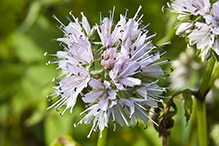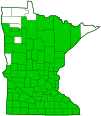Virginia waterleaf
(Hydrophyllum virginianum var. virginianum)
Conservation • Wetland • Description • Habitat • Ecology • Use • Distribution • Taxonomy
Description |
Virginia waterleaf, also called eastern waterleaf, is a 6″ to 30″ tall, erect, perennial forb that rises on multiple stems from fleshy, fibrous roots and a long, scaly rhizome. The stems are erect, hairless near the bottom, hairy above the middle with short, appressed hairs. Basal leaves are on stalks up to 5½″ long. Stem leaves are alternate and on shorter stalks, the stalks becoming gradually shorter as they ascend the stem. The leaves are broadly triangular in outline, 4″ to 8″ long, usually wider than long. They ate dark green and often have pale green or whitish markings on the upper surface that resemble water spots. They are deeplydivided into usually 5, sometimes 7 or 9, lobes cut almost to the midrib (pinnatifid). The two basal lobes and the terminal lobe are divided again into 2 or 3 lobes. All lobes come to a sharp point at the tip. The margins have sharp, forward-pointing teeth. The inflorescence is dense, compact, rounded clusters rising on forked stalks from the upper leaf axils and at the end of the stems. The flowers are bell-shaped, ¼″ to ⅜″ long on short stalks. The flower stalks have short, appressed, ascending hairs. They have 5 lavender to white petals, fused over half their length into a broad tube, then separating into 5 erect, flat-tipped lobes. There are 5 stamens with hairy filaments. The stamens and style extend well beyond the petals. The fruit is a 1-chambered capsule with 1 to 3 seeds. |
Height |
6″ to 30″ |
Flower Color |
Lavender to white |
Similar Species |
Great waterleaf (Hydrophyllum appendiculatum) is a somewhat taller plant with less deeply divided leaves and both short and long hairs on the stems. It reaches up to 48″ at maturity. Stem leaves are shallowly palmately divided into usually 5 lobes, giving them a maple-like appearance. The petals are lavender to pink, rarely white. The upper stems are densely hairy with both short and long hairs. The inflorescence stalk and the individual flower stalks are densely hairy. The stamens and style extend only slightly beyond the petals. In Minnesota it is found only in the southeast. |
Habitat |
Moist to wet. Woods. |
Ecology |
Flowering |
May to June |
Pests and Diseases |
|
Use |
|
Distribution |
||
|
Sources |
|
| 4/28/2025 | ||
Nativity |
||
Native |
||
Occurrence |
||
Common |
||
Taxonomy |
|
Kingdom |
|
Division |
Tracheophyta (Vascular Plants) |
Subdivision |
Spermatophytina (Seed Plants) |
Class |
|
Order |
Boraginales (borages) |
Family |
Boraginaceae (borage) |
Subfamily |
Hydrophylloideae (baby blue eyes, phacelias, and waterleaves) |
Genus |
Hydrophyllum (waterleaves) |
Species |
Hydrophyllum virginianum (Virginia waterleaf) |
Subordinate Taxa |
|
|
|
Synonyms |
|
|
|
Common Names |
|
eastern waterleaf John’s cabbage northern waterleaf Shawnee Salad Shawnee-salad Virginia waterleaf Virginia water-leaf |
|
Glossary
Palmately divided
Similar to a hand. Having more than three lobes that radiate from a single point at the base of the leaf.
Pinnatifid
Deeply cut, more than half way to the midrib but not to the midrib, into lobes that are spaced out along the midrib; the lobes do not form separate leaflets.
Rhizome
A horizontal, usually underground stem. It serves as a reproductive structure, producing roots below and shoots above at the nodes.
Visitor Photos |
||
Share your photo of this plant. |
||
This button not working for you? |
||
Luciearl |
 |
MinnesotaSeasons.com Photos |
||
 |
||
Habitat |
|
|
 |
 |
|
Plant |
Plant |
|
 |
 |
|
Inflorescence |
||
|
||
|
||
| Inflorescence |
|
|
 |
 |
|
Inflorescence |
Inflorescence |
|
 |
 |
|
Leaf |
Leaf |
|
 |
||
Leaf |
|

Slideshows |
|

Visitor Videos |
||
Share your video of this plant. |
||
This button not working for you? |
||
|
Other Videos |
||
Acrobat Ants Nectar Scraping Virginia Waterleaf |
About
Published on Jun 2, 2014 Virginia Waterleaf, Hydrophyllum virginianum, is a native ephemeral that is typically pollinated by bumblebees. Occasionally though ants, such as these Crematogaster cf. cerasi will steal the nectar, thus discouraging pollination. However these seem to only be nectar scraping the excess outside the petals. |
Virgina Waterleaf (Hydrophyllum virgianium) |
About
Uploaded on Apr 27, 2010 http://www.prairiemoon.com - Virginia Waterleaf is a very common woodland native plant. On April 1st at Prairie Moon Nursery, see the early spring "waterleaf" as it shows its 'water drops' growing in a moist woodland. |
bumble bee on flower |
About
Published on Jul 29, 2013 virginia Waterleaf mille lacs kathio 2007 |

Visitor Sightings |
||
Report a sighting of this plant. |
||
This button not working for you? |
||
Luciearl |
Location: Lake Shore, MN |
 |
MinnesotaSeasons.com Sightings |
||
Beaver Creek Valley State Park Bertram Chain of Lakes Regional Park Cannon River Turtle Preserve SNA Carpenter St. Croix Valley Nature Center Charles A. Lindbergh State Park Clifton E. French Regional Park Clinton Falls Dwarf Trout Lily SNA Forestville/Mystery Cave State Park Hardscrabble Woods / MG Tusler Sanctuary John Peter Hoffman Spring Brook Valley WMA Mary Schmidt Crawford Woods SNA Minnesota Valley NWR, Black Dog Unit Minnesota Valley NWR, Long Meadow Lake Unit Minnesota Valley State Recreation Area, Lawrence Unit Nerstrand Big Woods State Park P.N. and G.M. Nelson Wildlife Sanctuary Prairie Creek WMA, Koester Prairie Unit Robert Ney Memorial Park Reserve |

|
Created: 6/4/2005 Last Updated: © MinnesotaSeasons.com. All rights reserved. |
